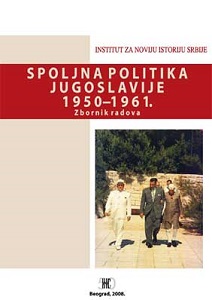Jugoslavija i Vatikan
Yugoslavia and Vatican
From Severance of Diplomatic Relations to the Second Vatican Council (1952–1963)
Author(s): Radmila Radić
Subject(s): Diplomatic history, Political history, Post-War period (1950 - 1989), History of Communism
Published by: Institut za noviju istoriju Srbije
Keywords: Yugoslavia; Catholic Church; Vatican; Alojzije Stepinac; Holy See
Summary/Abstract: Severance of diplomatic relations between Yugoslavia and Vatican has directly influenced the tightening of relations in the country between government agencies and the Catholic Church. Government agencies attempted to apply the tactic of pressure, on the one side and, on the other, to win over moderate bishops in order to show that the agreement with the Catholic Church is still possible in the situation when the re presentatives of Vatican are no longer present in the country. The Episcopate of the Catholic Church in Yugoslavia was divided between the extreme individuals who declined any compromise with the government agencies and the more moderate ones who proceeded from the position that changes in the country could not be expected in a short time and that it was better for the church to find ways for coexistence. However, they could not undertake anything without the consent of Vatican which was not willing to give such approval. At the same time, Vatican has pursued intense anti-Yugoslav campaign, which as a rule intensifi ed and was recalled the freedom of religion and church in the FPRY whenever Yugoslav representatives attempted to achieve something at the international level. Activities of Catholic clerical emigration with hostile attitude to the Yugoslav state have also been supported. The attitude of the Holy See toward Yugoslavia has largely depended on the general direction of Vatican policy toward socialist bloc states. Already at the beginning of 1955 there were various indications that Vatican was interested in renewing relations with Yugoslavia, but Yugoslav government bodies have rejected such attempt, hoping that they would be able to coax bishops in the country to negotiations that would bypass the Holy See. The turning point came in the late 1950s and early 1960, with the election of Pope John XXIII and death of Alojzije Stepinac. By that time rigidity in Yugoslavia has generally been eased and circumstances liberalized, including relations between the state and the church. The number of public attacks on bishops and clergy has declined. Mutual testing of ground lasted almost two years and led to the beginning of negotiations that resulted in the signing of the Protocol in 1966.
Book: Spoljna politika Jugoslavije 1950-1961.
- Page Range: 323-349
- Page Count: 28
- Publication Year: 2008
- Language: Serbian
- Content File-PDF

